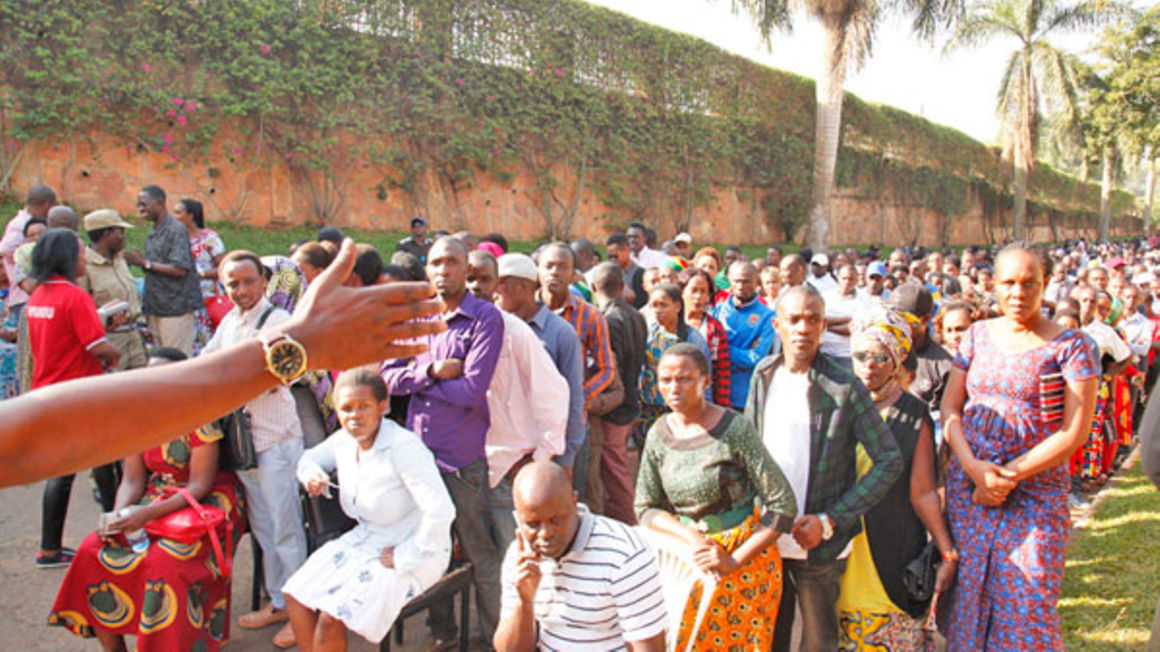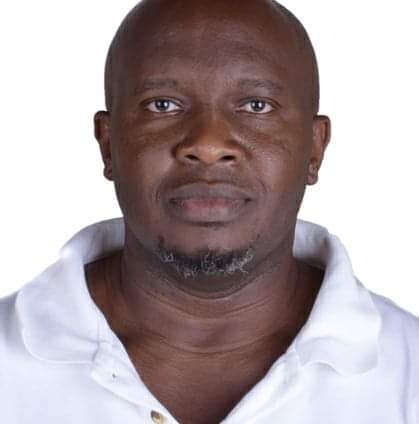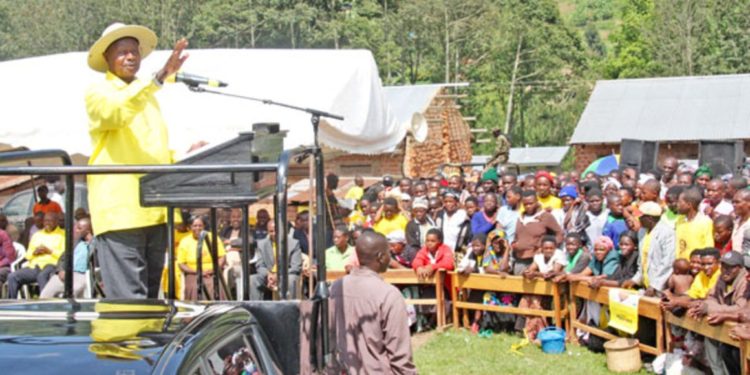By Edgar Tabaro
I was intrigued by President Museveni’s response to a follower identifying himself as Mwoyo Gwa Gwanga [Patriot], on his Facebook timeline, declaring how he is not against Banyankole but only against Banyarwanda like him (Museveni, allegedly).
The President rightly responded to Mwoyo Gwa Gwanga, giving him dynamics of cross border communities.
It’s my desire to deepen the debate on the Banyarwanda question of citizenship in the Great Lakes Region and challenge what I will call Rwandaphones in being treated as second class citizens in territories they are indigenous too.
During the 1991 Census, our family then residing in lower Kololo in Kampala was enumerated by an undergraduate law student at Dar es Salaam University in Tanzania called Michael Mugabe(now the chief executive officer of Housing Finance Bank).
The census was held at a time of an acrimonious debate over the introduction of “Urumfumbira” rather than “Ikinyarwanda” language on Radio Uganda.
You shall recall that the previous year, a section of the National Resistance Army (NRA) made up of mainly of Rwandese refugees and a significant number of Ugandan Banyarwanda had invaded Rwanda.
The invasion was to alter the course of history for Rwandaphones in the region and as such is a watershed in the dyanamics of identity of Rwandaphones.
My family had grown up identifying as Banyarwanda, a fact our grandparents were always alive to following our progress in learning Ikinyarwanda and its culture.
Back to the census, for the first time, the Bafumbira came up as a unique identity.
On the census national team was Col John Mateeka (now rtd Maj Gen). I would love to hear from him how this new identity was arrived at.
My parents, Justice and Ms Tabaro, tell us that in 1959, 1969 and 1980 (by this time, my sister Melissa Mafigiri and I were already born), we were enumerated as Banyarwanda.
How did our identity change suddenly? My guess is that it came off as “politically correct” to do, following continued “stigmatisation” and/or marginalisation of Banyarwanda/Rwandaphones in territories to which they originate outside of what is modern day Republic of Rwanda.
In the last two decades or even longer in some territories of the Great Lakes Region of Africa, the people answering to the description of Rwandaphone have often found themselves in predicament in relation to citizenship in the territories of what is modern day Tanzania, DR Congo, and Uganda and to some extent Burundi and Kenya.
Almost invariably, when the question of citizenship comes up for discussion in those territories, it’s the Rwandaphones (Kinyarwanda speaking people who are collectively known as Banyarwanda, a noun also associated with Banyarwanda of Rwanda, who are Rwandan or Rwandese) who take most of the criticism arising largely from ignorance and prejudice (the two are co-related, prejudice is largely conditioned by lack of information) against them.
I say so because as one who belongs to the Bafumbira ethnic grouping of Kisoro (one of the Rwandaphones in Uganda), I have witnessed firsthand this predicament rather than hearing it from other sufferers.
Many Rwandaphones feel terribly discriminated and marginalised, giving fertile ground for extremists and militarists to thrive and set the agenda for responses to injustices faced by these persons.
In the case of DR Congo, this has given rise to rebellions and counter-rebellions whose victims are the very persons whose human dignity they purport to restore! To this I will return later.
Two foremost writers on Rwandaphones in the Great Lakes Region- an American based social anthropologist Jan Vasina in his treatise Antecedents to Modern Rwanda: The Nyiginya Kingdom and Prof Mahmood Mamdani’s When Victims Become Killers: Colonialism, Nativism, and the Genocide in Rwanda, give the extent of the Rwanda Kingdom at the height of its power under Umwami Rwabugiri (1867-1897), as reaching Bumpaka in present day Busongora (Lake Kasenyi) in Kasese, Karagwe, Ngara and Buha in present day Tanzania, Bushi and Butembo, covering the present day Nord (North), Sud (South) Kivu and a few in the present day Maniema province of the eastern DR Congo. Advertisement
These areas have “indigenous” (this term is used loosely as issues to do with indigenousness in Africa are not as clear cut a Aboriginal groups of the Americas and Australia in that sense) Rwandaphones populations.
Later day immigrants from what is present day Rwanda started in the early 1900s following the introduction of cash-crops in Buganda and Tooro. They came to work as wage earners for Buganda and in the case of DR Congo, there was an influx of immigrant Rwandaphones between 1900 to 1960 to Shaba (present day Katanga) Province following opening up of mineral production in the area, and the rail links by the Belgian authorities.
Other immigrants found their way to the European plantations in what is now known as the Kivus.
These later day immigrants, although they lawfully acquired citizenship in Uganda and DR Congo, are not to be confused with the indigenous Rwandaphones.
In Uganda, the indigenous Rwandaphones mainly occupy the districts of Kisoro (Bufumbira County), Kabale (largely in Kamwezi Sub-county) and Ntungamo.
Though these groups continue to identify themselves as Banyarwanda, there are many Banyarwanda from Bufumbira who resent the nomenclature and have opted to identify themselves as Bafumbira, largely arising from the confusion of the noun Banyarwanda being descriptive as persons from Rwanda!
This comes as an irony, persons from Kisoro were enumerated as Banyarwanda in the 1959, 1969, as well as 1980 Uganda Population and Housing Census.
In the 1991 Population and Housing Census, the same people were enumerated as Bafumbira as their chosen identity following a storm over the introduction of the Kinyarwanda language on the then Radio Uganda.
This resulted into a callus led by the Council Member (CM) for Bufumbira County, Dr Philemon Budigi Mateke, for recognition of Urufumbira as a distinct language” from Kinyarwanda and the same CM (MP) did represent one of the three constituencies of Bufumbira in the Constituent Assembly, thereby ensuring the same identity gained recognition in the 1995 Constitution as an indigenous group of Uganda.
Last border adjustment
The other Banyarwanda also did gain recognition as being indigenous. More ironically or perhaps not so ironical, the said council member is quoted in the Hansard of 1990, when the National Resistance Council was debating the Mugerwa Report on the Commission of Inquiry into the Nkore (Ankole) – Masaka Ranching Scheme, as responding to queries of other members as to the nationality of some Banyarwanda who had been re-allocated some ranches by asking the House not to confuse Rwandan Banyarwanda and Ugandan Banyarwanda like himself!
The Banyarwanda who are native to the territories of Uganda as those of Bufumbira became part of the then Uganda Protectorate under British dominion after the Brussels Convention of 1910, and the immigrants became indigenous owing to the “magical” February 1, 1926 being the date of the last border adjustment to what became known as the territory constituting the Republic of Uganda. This recognition was attained without firing a shot!
Enter DR Congo, some Banyarwanda there continue to suffer rejection and in many instances have been denied voting rights by the rest of the Congolese populace.
DR Congo, like Uganda, has both native and immigrant Banyarwanda and the former are often confused with the later. This is further compounded by attempts by the successive Kinshasa administrations to craft definitive laws on Rwandaphones and citizenship largely based in subjective rather than objective realities on the ground.
In one instance, a later day Rwandan immigrant into DR Congo of 1960 had gained prominence at the court of Gbadolite as Chef de Cabinet- Principal Secretary of President Mobutu and influenced the same to pass a decree in 1973 to recognise those immigrants as of 1960, though it was never to take effect.
Just like the Banyarwanda of Bufumbira chose to identify themselves as Bafumbira in connection with the geographical location of their dwelling place, the DR Congo Rwandaphones too adopted a similar approach, thus you will hear them identify themselves as Banyamulenge (from Milenge Hills), Banyejomba (from Jomba), Bashi (from Bushi), Banyerutsuru (from Rutshuru) and Banyemasisi (from Masisi), among others.
The trouble here is that there are other ethnic groupings from those areas and exclusively identifying oneself as being of that area often times causes tensions with other communities, resulting in ethnic clashes that draws in other militias and the Kinshasa forces.
This is coupled with constant suspicion against those Rwandaphones serving in national army, who suffer discrimination a result of which they fear serving outside their localities.
In one instance, the Kinshasa administration introduced the policy of “mixage” in the army (serving outside ones area of birth) but a few but critical mass of officers rebelled and took to the bushes to protest this alleged discrimination.
The M23 rebellion and previous clashes in the Kivus in the past bear testimony to this suffering.

On November 10, 2013, I did pen a missive entitled “Rwandaphones and the Question of Citizenship in the Great Lakes Region: Arms vis avis Dialogue” to inform and deepen the debate on the question of citizenship of the Banyarwanda people who straddle across the territories of what is now modern day DRC (Sud Kivu, Nord Kivu, Maniema, and Shaba/Katanga Pronvices), Tanzania (Ngara, Karagwe- Buhanganza), Uganda (Bufumbira/Kisoro, Kabale- Kamwezi Sub-county and Ntungamo).
The said missive went into fair detail the history of the Banyarwanda people in those territories and as to how they became bonafide citizens of the said territories.
To my utter shock and consternation, a senior journalist and editor at one of the leading dailies, in an ill-advised diatribe, wrote on his facebook wall vulgar vituperations against the Banyarwanda Community- labeling them refugees in Uganda who ought to be deported back to Rwanda their alleged country of nationality.
The said journalist did comment in passing on the KFM Friday panel of journalists on November 29, 2013, where he appeared together with Onapito Ekomoloit, Nicholas Ssengooba, Timothy Kalyegira and James Tumusiime, wherein he admitted to making uncharitable comments on facebook that have put him in a spot of bother.
When the going got tougher as a result of the backlash from mainly Banyarwanda and Banyarwanda sympaithisers, he changed the script to “his facebook account had been hacked into”.
I did post a comment on my facebook timeline then calling for fellow Banyarwanda to forgive the said journalist and instead educate him on the subject as to how Banyarwanda like any other community (the said journalist is believed to be an Itesot- the same are found in Kenya as well) of Uganda can be found domiciled as natives of other countries as well.
What followed was utterly shocking, persons I hitherto regarded as enlightened (my assumption is based on the “elite” schools they attended, the religious assemblies they attend and the somewhat cosmopolitan work places and friends they fraternize with) and my friends re-echoed the same opinions of the journalist, totally ignoring the message I had put out.
Banyarwanda citizenship
The bigotry and phobia against Banyarwanda citizenship is deep and largely based on prejudice itself arising out of ignorance or obscurantism. The same challenge is faced by Congolese Banyarwanda!
The questions they posed, were mainly how can we have Rwandan Banyarwanda and Ugandan Banyarwanda? That Banyarwanda are divided into the tribes of Hutu, Tutsi and Twa, so who are those Banyarwanda in Uganda, and that Banyarwanda in Uganda regard the rest as subhuman and it is the reason they dominate in all spheres of life in Uganda, thereby suffocating other communities. It is my intention to throw some light on some of these issues.
Firstly, the stratification of Banyarwanda into Hutu, Tutsi and Twa is not tribal or ethnic identities but rather has to do with socio-economic stratification.
The class system developed in response to the primordial mode of production prevailing under the pre-colonial epoch in the ancient kingdom of Rwanda. Thus, the cattle keepers became Tutsi and the cultivators became Hutus and the hunter gatherers became Twas.
Over the years, depending on one’s means of livelihood, there would be mobility between the socio-economic strata.
Because cattle keeping was considered nobler than the other economic activities there developed mannerisms associates with this class, perfection of language abilities, poetry, dance and drama, and marrying the most aesthetically endowed women (I guess money can still buy you this), thereby ensuring the progeny of this class looked a lot more different from the other (I am reliably informed that the present generation of the Chinese population is taller than the previous one owing to improved socio-economic conditions).
When the German colonists and later the Belgian ones took over Rwanda, bewildered by the organic composition of the Rwanda Kingdom, they formed the opinion that tribal (etymology connotes primitive grouping) Africans could never have developed sophisticated systems of statehood and as such, to them, the aristocrats in Rwanda were a lost community from Europe, thereby solidifying the so-called racial theory.
Over the years, political divisions crystallised upon this false premise hence the Hutu-Tutsi rivalry that has been wrongly prescribed as ethnic.
Early recorded migrations of Banyarwanda to Uganda in their hordes was at the beginning of the first decade of the 20th Century, when cash crop was introduced by Mitchel Cotts the successor to the Uganda Company (incorporated 1896) itself a successor to the Imperial British East Africa Company (IBEACO) that had a royal charter. The early migrants are mainly in areas of tea production in Namutamba and Tooro where they worked as wage earners although a good number took up other menial jobs in other counties of Buganda and their descendant continue to live.
In 1910, the Anglo – German – Belgian conference was held in Brussels, which resulted in agreement on Volcano Sabinyo as the tripoint of the territories of the three states, delimited the present Congo – Rwanda and Burundi – Congo boundaries, and delimited the parts of the Congo – Uganda and Tanzania – Uganda boundaries adjoining the tripoint.
This Convention between Belgium and Germany confirming the Agreement was signed at Brussels, on May 14, 1910, settling the boundary between German East Africa and the Belgian Colony of the Congo.
Signed at Brussels, August 11, 1910, further on a Protocol between Great Britain and Germany Describing the Frontier between the Uganda Protectorate and German East Africa. Signed at Kamwezi, October 30, 1911.
Memorandum attached to the Protocol List of Boundary Pillars on the Anglo – German Boundary, Sabinio to River Chizingo, with approximate Co-ordinates.
These two legal documents transferred territories of Rwanda Kingdom Provinces of Bufumbira (present day Kisoro District), and Ndorwa (present day Kabale, Rubanda and Rukiiga Districts) and areas of Ntungamo that were inhabited by native Banyarwanda communities.
It is worth noting that these are the persons referred to an Banyarwanda as the indigenous community of Uganda as per the 3rd Schedule to the Constitution,though the ones of Bufumbira assumed the identity of Bafumbira.
For a long time under both colonial and post-colonial administrations in Uganda, the areas inhabited by the Banyarwanda communities did not benefit from any form of affirmative action, a result of which the community was heavily impoverished.
Infact, it was a deliberate government policy to reserve the areas as a cheap source for labour for the plantations and other richer agricultural regions. However, over the years, descendants of these people have been lifted out of the shackles of poverty and ignorance, which may not necessarily endear them to other communities hence exacerbating their resentment.
To this end, the Constitution of the Republic of Uganda, the following persons shall be citizens of Uganda by birth—
(a) every person born in Uganda one of whose parents or grandparent/s is or was a member of any of the indigenous communities existing and residing within the borders of Ugandaas at the first day of February, 1926, and set out in the Third Schedule to this Constitution.
Uganda’s indigenous communities as at February, 1 1926 which forms the date to the last border adjustment to the Protectorate of Uganda that transferred the Easter Province to the Kenya Colony ,which is now the Rift Valley up to Lake Rudolf (Turkana).
This 1926 adjustment is at the centre of the conflict over Migingo Islands! In this regard, the question of the Banyarwanda citizenship should not arise in the first place.
This article was first published by The Daily Monitor.

The writer is an advocate with KTA Advocates and an ex Attorney General of Tooro Kingdom. He has keen interest in East African integration.







